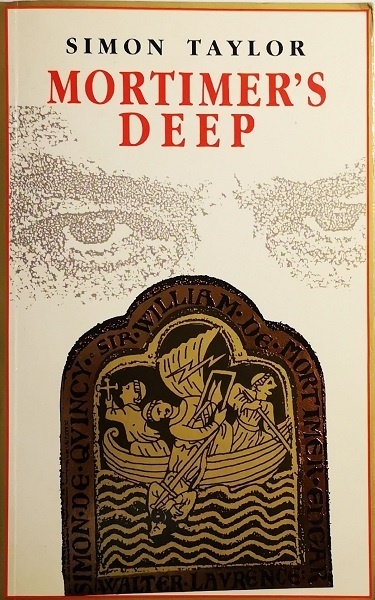Mortimer’s Deep by Simon Taylor
Balnain Books, 1992
Translated into German by Rainer Schmidt. Published as Der Mönch by four German publishers including Weltbild (Augsburg, 2004).
Mortimer’s Deep – It’s Origins
Off the Fife coast, near the village of Aberdour, lies the island of Inchcolm, where the stark ruins of a monastery are visible across the water.

The channel between the village and the island is known as Mortimer’s Deep. It’s a dangerous stretch of water. One story says that around 800 years ago a group of monks were taking the body of a nobleman named De Mortimer to the island for burial. A storm blew up, the boat began to sink. And the monks threw the body into the Forth to save their lives.
The name of the channel is the only suggestion that this really happened. But Simon Taylor, a medieval scholar, takes the legend as the starting point of his vision of queer and Scottish medieval history.
Changing Light
The novel begins in 1224 as Martin de Dunfermline, a young church clerk, travels to Inchcolm Priory. He is on a mission he conceals from everyone. To learn the truth about the proud, brilliant and cruel Prior Simon de Quincy, his former mentor.
As Martin crosses the Forth, the water, and the stone of the priory change colour as the clouds come and go. There are many journeys to Inchcolm in the novel. And everything shifts and transforms for the characters as they leave the ordinary world.
The changing light on Inchcolm is a warning for the reader as well as for Martin. We can look into the queer past, but we can’t be sure what we are seeing. Taylor builds the vision of Scottish and queer history in his novel on a structure of fact.
Mortimer’s Deep takes place mainly at the end of the 12th century, during the reign of William the Lion in Scotland and (among others) Richard the Lionhearted in England. There was no shortage of lions, wolves, foxes and other predators in politics or the church. Joining a monastery was a retreat from the world, but it was a life of hardship and, for queers, condemnation by the church.
‘Spiritual friendship’
However, when Mortimer’s Deep was written in the 1980s, perceptions of queer history were in flux. The American historian John Boswell had just published his controversial book, Christianity, Social Tolerance and Homosexuality. Boswell found evidence of tolerance of same-sex relationships in early Christian writings – and in some cases, support.
In the novel, Simon Taylor acknowledges his debt to Boswell. As punitive as the church was, especially after the 12th century, Boswell believed there were also long-lasting traditions of same-sex ‘spiritual friendship.’

On Inchcolm, Martin de Dunfermline meets an old monk who speaks for those traditions. Once handsome, now old and blind, Brother Michael has been forgotten by most of the monastery. But it turns out he was once Prior Simon’s lover.
Martin eagerly begins talking to him. Brother Michael agrees to tell him what he knows about the mysterious Simon. But in exchange, he asks that Martin hear his own story, from the early days when he fled to Inchcolm to escape Sir William de Mortimer, his sexually abusive master, and found refuge on the island. He speaks for the life of the monastery – the harsh conditions, the trivial quarrels – and the attempt to reconcile monastic ideals with the love for other men which sustains Michael’s sanity.
Making the past speak
Michael’s story deals with Scots royal quarrels, intrigues among cardinals, false miracles, mysterious deaths, and the corrupt papal court in Rome. His own good looks, he says, have been his curse. But his conscience and honesty have brought him nearly as much trouble. A complex character, he makes the past speak, for Martin – and for us.
The novel works on several levels. It is a mystery story, which follows Martin’s quest to unravel the life of Simon de Quincy and his own past. It is a story of the friendship between Brother Michael and Martin. But it is also a gothic novel, sometimes a horror story, and the multilayered story of a same-sex community.
Simon Taylor researched his story closely. The church intrigues of the time and Scotland’s tangled relationship with England and the Papacy are woven into the plot. At the end is a unique feature – a catalogue of characters with the known facts about them in ordinary type and the novel’s inventions in italics.
Mortimer’s Deep – It’s Legacy
Mortimer’s Deep was published in 1992 in an edition with a coppery, textured cover by the small Scottish publisher Balnain. But, like its hero, it also travelled on the continent. Mortimer’s Deep was featured on the continent at European bookfairs, thanks to the Scottish Publishers Association (now Publishing Scotland). It was translated by the German publisher Schneekluth. Promoted with a tv appearance and a CD featuring monastic chants, it went through four German editions as Der Mönch – The Monk. Like many queer novels, it found more than one home and survived.



Leave a Reply